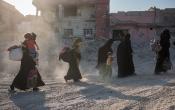Syrian Arab Republic
Operation: Syrian Arab Republic
Location
{"longitude":39,"latitude":35,"zoom_level":0,"iso_codes":"'SYR'"}
By clicking on the icons on the map, additional information is displayed.
Key Figures
| 2017 year-end results | |
| 3,000,000 | people were provided with core relief items |
| 2,600,000 | people were reached with protection activities |
| 480,000 | people were supported with health services, including access to primary health care and psychosocial services |
| 36,100 | refugees were assisted with cash assistance |
| 2018 planning figures | |
| 2,725,000 | IDPs, host community members and returnees will benefit from non-food item distribution |
| 300,000 | IDPs, spontaneous returnees, and other vulnerable people in affected populations will receive legal assistance |
| 240,000 | IDPs and returnees will benefit from emergency and long-term shelter interventions |
| 200,000 | vulnerable IDP students will benefit from remedial and catch-up classes |
| 90,000 | IDPs and host community members will benefit from livelihood activities |
Latest Updates and Related Links
People of Concern
6%
Increase in
2016
2016
| 2016 | 7,131,910 |
| 2015 | 6,753,569 |
| 2014 | 7,947,655 |

[["Refugees",19809],["Asylum-seekers",12494],["IDPs",6325978],["Returned IDPs",600000],["Returned refugees",1],["Stateless",160000],["Others of concern",13628]]
Loading ...
Syrian Arab Republic
< Back
2017
{"categories":[2013,2014,2015,2016,2017,2018],"budget":[317.92470594,331.41534753,366.77411747,315.69039415,497.600068126,612.18900002],"expenditure":[231.88147006,205.04924968,173.76697349,137.49994288,159.72845298,null]}
{"categories":[2013,2014,2015,2016,2017,2018],"p1":[84.23797468,69.84079225,56.81599041,52.75013228,47.39999955,47.24606579],"p2":[0.70832734,0.57833829,0.17973042,0.1946423,0.21116958,0.19864073],"p3":[null,null,null,null,146,259.2],"p4":[232.97840392,260.99621699,309.77839664,262.74561957,303.988898996,305.5442935]}
{"categories":[2013,2014,2015,2016,2017,2018],"p1":[40.80187504,40.86751359,23.27234083,23.57270191,16.49820621,null],"p2":[0.29587007,0.44117528,0.12660126,0.10932031,0.007318,null],"p3":[null,null,null,null,4.84129756,null],"p4":[190.78372495,163.74056081,150.3680314,113.81792066,138.38163121,null]}
Loading ...
CHOOSE A YEAR
- 2014
- 2015
- 2016
- 2017
- 2018
Operational context
The year 2017 was marked by a turning point in the crisis in the Syrian Arab Republic (Syria) with the expansion of the Government’s territorial control, and the decrease of populations in besieged areas through local reconciliation agreements. Areas of relative stability emerged where the return of IDPs increased. An estimated 840,000 Syrians returned spontaneously to their areas of origin during 2017, including 77,000 refugees from neighbouring countries. However, conditions for return in safety and dignity are not yet in place and UNHCR does not promote, nor facilitate, the return of refugees to Syria.According to the 2018 Humanitarian Needs Overview (HNO), as of November 2017, the total number of people in need has slightly decreased from 13.5 million to 13.1 million, largely due to increased accessibility to some areas both for civilians and humanitarian actors. At the same time, humanitarian needs continue to remain high in UN-declared besieged and hard-to-reach areas, while in other parts, mostly in north-east Syria, needs have grown following an escalation in hostilities and a significant increase in displacement.
While the number of IDPs is estimated to have decreased from 6.3 million to 6.15 million over the year, overall monthly displacement rates remained high in 2017. The needs of 3 million people in hard-to-reach locations, including 419,000 in besieged areas, continue to be particularly severe and remained largely unmet.
Against the disruption caused by prolonged hostilities and multiple displacement, the population’s capacity to mitigate protection risks has diminished due to, among others, the depletion of resources, disruption of livelihoods, exhaustion of savings, psychosocial distress, deepening vulnerabilities based on gender, age and other factors, and increasing reliance on harmful coping mechanisms. Furthermore, housing, land and property (HLP) rights and civil documentation issues have emerged as serious protection concerns.
Although Syria maintains a generous approach to refugees and asylum-seekers despite the crisis, the protection environment for this population group has deteriorated. The protection risks to which refugees are exposed in a war-torn asylum country, the lack of prospects for durable solutions and the prohibition to engage in formal employment, combined with UNHCR’s limited budget leading to a reduction in cash assistance, have impacted negatively on the coping strategies of refugees who are on the brink of survival.
Population trends
New displacements continued to occur due to sustained or increased violence in several parts of the country, with some 1.8 million people newly displaced in 2017 according to the 2018 HNO. At the same time, spontaneous returns of IDPs and, to a lesser extent, refugees, continued to take place to other areas where the level of hostilities declined or ceased and which became more accessible. It is estimated that some 764,000 IDPs and 77,000 refugees returned in a self-organized manner during 2017.By December 2017, the population of refugees and asylum-seekers was close to 49,000. This included some 19,400 refugees mostly residing in Damascus and Al-Hassakeh governorates who are predominantly from Iraq (some 80 per cent); 18,100 asylum-seekers, mostly residing in urban Qamishli; and more than 11,200 Iraqi asylum-seekers located in three camps (Newroz, Roj and Al Hol) in Al-Hassakeh Governorate. There was a significant reduction in the camp-based population due to nearly 19,000 people returning to Iraq under bilateral arrangements of the authorities since late 2017.
Key achievements
- In order to maximize outreach, UNHCR extended its partnership network to encompass new international and national NGOs, increased its existing network of community centres to 92, established 10 new satellite centres and 58 mobile units and expanded the outreach volunteer programme from 1,770 at the end of 2016 to 2,190 at the end of 2017.
- UNHCR supported nearly 480,000 people (96,000 households) through the shelter programme in 12 governorates. UNHCR exceeded the shelter target set initially for 2017 (94,500 individuals), mainly in response to emergency needs in north-east Syria and because access to return areas improved significantly.
- The psychological needs of the population in Syria are still on the rise due to the prevailing extensive stress factors linked to the protracted crisis and its effects, resulting in the need for sustainable services of mental health and psychosocial support. In 2017, UNHCR provided mental health and psychosocial support services in 11 governorates through community centres, mobile teams and the Refugees Outreach Volunteers(ORVs), as well as through its six Primary Health Center services in two governorates; Damascus and Rural Damascus.
Unmet needs
- Over 1.75 million children remained out of school due to insecurity and/or destruction of education facilities, absence of safe learning spaces and fear from attacks, lack of adequate learning and teaching materials and personnel.
- Livelihoods remained a dire and unaddressed need among the displaced and crisis-affected populations in Syria, with 53 per cent of the working age population without employment. The unemployment rate among youth is particularly high, 75 per cent, exposing the youth to various protection risks.
- The need for civil registration and documentation among IDPs remained high. Civil registration and issuance of documentation are constrained by the absence of functioning civil registration services in areas outside government controlled locations as well as shortfalls of resources.
- The resource cuts to refugee assistance resulted in reduced response activities in the areas of medical care, livelihoods, education and other essential services. In-kind material assistance to peoples with specific needs, such as hearing and vision devices, could not be provided.
Working environment
Six years of conflict has had a devastating impact on the lives of all civilians in Syria, with humanitarian needs reaching an alarming level. According to the 2016 Humanitarian Needs Overview (HNO), 13.5 million persons are in need of humanitarian assistance, including 6.1 million internally displaced people (IDPs). Escalation of the conflict in 2016 led to a deterioration in the security environment and a further increase of internal displacement, consequently impacting the humanitarian situation. United Nations agencies and their partners were limited in their ability to deliver life-saving humanitarian support, particularly to the 5.47 million people living in besieged and hard-to-reach areas. The humanitarian situation in the city of Aleppo and its surroundings has deteriorated severely, with some 275,000 people in the eastern part of the city facing movement restrictions and in need of urgent assistance. Almost all aspects of civilian life have been affected, resulting in a range of interlinked protection risks.Key priorities
UNHCR’s key priority in 2017 will be to continue providing life-saving assistance to IDPs across the country; particularly in hard-to reach and besieged areas, in order to address the large-scale humanitarian needs throughout all governorates. UNHCR will continue to engage the Government in raising protection concerns and finding appropriate solutions. UNHCR will continue to focus on enhancing the protection of people of concern through a wide range of integrated community-based activities, with particular attention to improving access to civil documentation, strengthening the prevention of and response mechanisms to sexual and gender-based violence (SGBV), and the protection of chil¬dren as well as services for persons with specific needs. UNHCR will also work towards strengthening the resilience and reducing vulnerabilities of people affected by the conflict. UNHCR will continue to register new asylum-seekers, provide protection services and identify durable solutions including resettlement and voluntary repatriation for refugees. In the context of the whole-of-Syria approach, UNHCR will continue to lead the Protection, Shelter and Non-Food Items (S/NFI), and Camp Coordination and Camp Management (CCCM) clusters, and deliver cross-line and cross-border assistance to affected populations.The comprehensive needs of the UNHCR operation in Syria for 2017 amount to USD 353 million. In the event of funding shortfalls, some 77,500 IDPs will be left without emergency shelter; at least 500,000 individuals, will not have access to 40 community centres which would have been established; 250,000 IDPs will not receive psychosocial support; 400,000 families will not receive urgently needed core relief items (CRIs); and monthly financial assistance will only be provided to 20 per cent of the refugee population.




